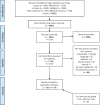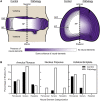Innervation of the Human Intervertebral Disc: A Scoping Review
- PMID: 33595648
- PMCID: PMC8185559
- DOI: 10.1093/pm/pnab070
Innervation of the Human Intervertebral Disc: A Scoping Review
Abstract
Objective: Back pain is an elusive symptom complicated by a variety of possible causes, precipitating and maintaining factors, and consequences. Notably, the underlying pathology remains unknown in a significant number of cases. Changes to the intervertebral disc (IVD) have been associated with back pain, leading many to postulate that the IVD may be a direct source of pain, typically referred to as discogenic back pain. Yet despite decades of research into the neuroanatomy of the IVD, there is a lack of consensus in the literature as to the distribution and function of neural elements within the tissue. The current scoping review provides a comprehensive systematic overview of studies that document the topography, morphology, and immunoreactivity of neural elements within the IVD in humans.
Method: Articles were retrieved from six separate databases in a three-step systematic search and were independently evaluated by two reviewers.
Results: Three categories of neural elements were described within the IVD: perivascular nerves, sensory nerves independent of blood vessels, and mechanoreceptors. Nerves were consistently localized within the outer layers of the annulus fibrosus. Neural ingrowth into the inner annulus fibrosus and nucleus pulposus was found to occur only in degenerative and disease states.
Conclusion: While the pattern of innervation within the IVD is clear, the specific topographic arrangement and function of neural elements in the context of back pain remains unclear.
Keywords: Annulus Fibrosus; Back Pain; Intervertebral Disc Degeneration; Neuroanatomy; Nucleus Pulposus; Peripheral Nervous System.
© The Author(s) 2021. Published by Oxford University Press on behalf of the American Academy of Pain Medicine.All rights reserved. For permissions, please e-mail: journals.permissions@oup.com.
Figures


References
-
- Herkowitz HN, Dvorak J, Bell GR, Nordin M, Grob D.. Epidemiology and the economics of low back pain. In: Epidemiology and the Economics. Philadelphia: Lippincott Williams & Wilkins; 2004:3–10.
-
- James SL, Abate D, Abate KH, et al.Global, regional, and national incidence, prevalence, and years lived with disability for 354 diseases and injuries for 195 countries and territories, 1990–2017: A systematic analysis for the global burden of disease study 2017. Lancet 2018;392(10159):1789–858. - PMC - PubMed
-
- Chou R, Shekelle P.. Will this patient develop persistent disabling low back pain? JAMA 2010;303(13):1295–302. - PubMed
-
- Deyo RA, Weinstein JN.. Low back pain. N Engl J Med 2001;344(5):363–70. - PubMed
-
- Deyo RA, Mirza SK, Martin BI.. Back pain prevalence and visit rates: Estimates from U.S. national surveys, 2002. Spine (Phila Pa 1976) 2006;31(23):2724–7. - PubMed
Publication types
MeSH terms
Grants and funding
LinkOut - more resources
Full Text Sources
Other Literature Sources

